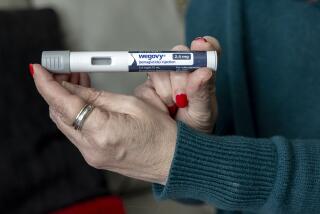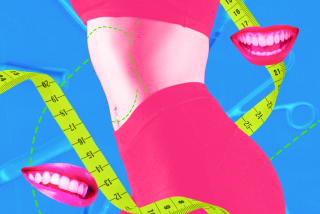Flaxseed Has Benefits but Doesn’t Lower Cholesterol
Natural remedies to relieve menopausal symptoms are attracting lots of attention since the recent news that hormone replacement therapy carries a slightly increased risk of heart attack and stroke.
But few natural therapies, such as herbs and other plant products, have been rigorously tested for their effects on menopausal women--and fewer have been examined in comparison with hormone therapy. A new study, however, is among the first to do just that, and the results show that natural doesn’t always mean better.
The study found that flaxseed supplementation and hormone therapy were equally effective in treating mild menopausal symptoms such as hot flashes. But only the hormone regimen (estrogen, or estrogen plus progesterone) was helpful in lowering the women’s cholesterol.
Researchers at Universite Laval in Quebec, Canada, assigned 25 postmenopausal women with high cholesterol levels to a four-month cholesterol-lowering diet followed by two months on either flaxseed supplements or hormones. After a two-month break, the groups switched treatments. The 40 grams per day of flaxseed was provided in bread and in ground flaxseed that was added to other foods.
Flaxseed comes from the flax plant and contains the most concentrated food source of lignan, a type of plant hormone that is similar to estrogen. Among postmenopausal women, the supplement, which can be purchased as crushed grains or oil, is popular for hot flashes and to reduce the risks of heart disease and osteoporosis, although those uses are unproved.
While other studies have suggested that flaxseed can alter cholesterol levels, the Canadian study found that LDL (or “bad”) cholesterol fell 15.9% on hormones but only 1.6% after flaxseed use. Hormone use also boosted other favorable markers related to cardiovascular health in comparison with flaxseed.
Flaxseed remains of interest to researchers in other fields. Preliminary studies have shown it may help protect postmenopausal women against breast cancer. Other studies have shown it might curb prostate cancer growth.
Obstetrics & Gynecology 100 (3): 495-504
Low-Dose Birth Control Pill May Reduce Side Effects
Women who are troubled by birth control pills’ side effects, such as breast tenderness, bloating and nausea, may benefit from a lower-dose oral contraceptive.
The Food and Drug Administration has approved a variation of the nation’s bestselling birth control pill. The new pill, Ortho Tri-Cyclen Lo, contains 25 micrograms of estrogen, which is 10 micrograms less than the original Ortho Tri-Cyclen. Both versions contain the same dose of progestin. The lower-dose pill was approved Aug. 23 and is expected to be available this fall.
Some birth control pills currently on the market contain even less estrogen, and they are effective at preventing pregnancy, says Dr. Ronald T. Burkman, chairman of obstetrics and gynecology at Baystate Medical Center in Springfield, Mass. The downside of these very low-dose pills is that there is a greater risk of bleeding between periods.
Adding just a little more estrogen, Burkman says, lowers the chances of breakthrough bleeding and spotting. Burkman has been involved in several clinical trials of Ortho Tri-Cyclen Lo.
There is another birth control pill on the market that also contains 25 micrograms of estrogen, but a different type of progestin than Ortho Tri-Cyclen Lo. “Progestins play a role in bleeding as well,” says Burkman, “and the properties of the different types of progestin vary.”
Depressed Teens More Likely to Become Obese
For teenagers, depression may be as great a contributor to obesity as temptingly large portions of fast food or soft drinks in the school lunchroom.
A study of 9,374 adolescents found that those who were obese and depressed were likely to be even more overweight a year later. The researchers, from Cincinnati Children’s Hospital, also found that a depressed mood doubled the risk of obesity in those who were not obese when the study began. The risk of obesity in depressed teens remained high even when researchers eliminated physical activity, smoking and parental obesity as factors.
When the study of seventh-to 12th-graders started, there was no difference in the incidence of depression among the obese, overweight and non-obese students. One year later, most of those who were obese at the start of the study were still obese, and the incidence of obesity increased in the overweight and normal groups. The researchers found that 12.4% of those who were depressed at the start of the year were obese the following year, compared with 9.4% of those who were not depressed.
Experts have been unsure whether obese children tended to be depressed or if depression led to obesity. Other studies had suggested that the feelings of shame, guilt and embarrassment associated with the stigma of obesity could lead to depression. And some research had shown that depression was linked to the development of obesity in women. But this investigation, which followed teenagers of both sexes for a year, led the researchers to believe that in many cases the depression comes first, even in boys.
“Most people think that obesity leads to depression, not vice versa. But there is emerging evidence that mood disorders can, in fact, predispose individuals to become obese because both mood and weight share regulatory pathways in the brain,” says Dr. Elizabeth Goodman, the study’s lead author and professor of child and adolescent health at Brandeis University.
Pediatrics 109 (3): 497-503
The Complex Links Between Exercise and Arthritis
Regular exercise helps relieve the pain of arthritis, but some people with achy joints have a hard time getting started. They try to become more active, but then pain kicks in, forcing them to stop.
Now research on men and women with osteoarthritis in one or both knees has confirmed that that there is a “pain hump” after exercise. But quitting doesn’t help. In fact, inactivity could make pain worse.
Thirty-two overweight older people participating in a larger study at Wake Forest University in North Carolina agreed to keep track of the pain caused by their arthritis for six straight days. Every other day, the previously sedentary people exercised from 11 a.m. until noon--warming up, doing two 15-minute walks and 20 minutes of strength training, and then cooling down.
Their pain followed a typical pattern, peaking in intensity between 3 and 4 p.m. and then gradually decreasing throughout the rest of the day. The exception was on the exercise day, when the pain intensified immediately after their workouts.
But usually within an hour after exercise, the discomfort began to subside and continued diminishing over the remaining day. Since the pain didn’t remain high, the researchers concluded that the exercise triggered it.
Warning people to expect this temporary spike in pain when they first start to exercise may help them stick with their exercise program, researchers say. Eventually, the regular exercise is likely to decrease their discomfort.
Annals of Behavioral Medicine 24 (3): 201-210
*
Dianne Partie Lange can be reached at DianneL[email protected].
*
Staff writer Shari Roan contributed to this report.






